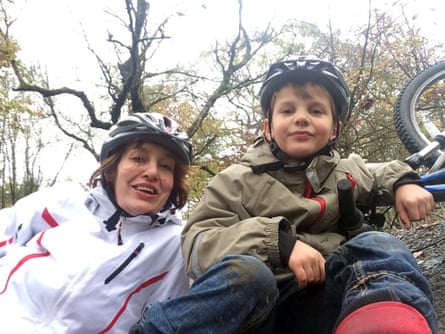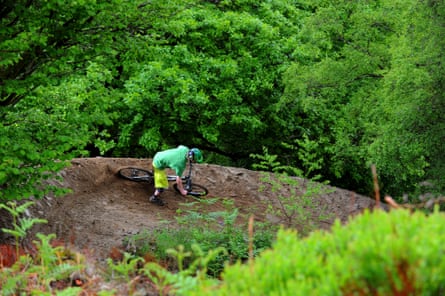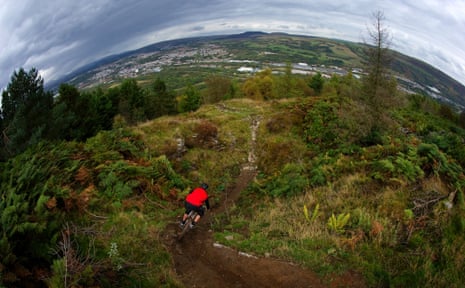I love rain, Wales, bikes and mini-breaks. I don’t mind long drives and I haven’t spent two nights on my own with my son, Thurston, since the night he was born, and the night after, seven years ago. He hates rain, doesn’t know much about Wales, loves hotels (“I definitely think this is the best place we’ve ever been,” he said, as we arrived at the reception of Nant Ddu Lodge and someone smiled at us), is OK on a bike, and was really pleased to have a weekend away with me until he found out that there was no Wi-Fi.
We were perfect for BikePark Wales, a £1.8m mountain bike park that opened in Merthyr Tydfil in 2013 – except that we’re pathetic physical cowards, both of us. We’re like relay-jellyfish: the minute one of us gets up the courage to do anything, the other freaks out. Which is why we’re trying out the private lessons the park now offers, to see how they cope with scaredy-cat mountain biking novices.
The park is one of eight purpose-built centres now operating in Wales, in addition to several bases with several mapped and way-marked trails.
Thurston’s first question to Anna Walters, one of the team who set up BikePark Wales, was about the worst accident she’d ever had. “I broke my collarbone in five places,” she said.
“You’ve done that! Tell her you’ve done that,” I commanded, then felt nauseous as I started to relive it.
“It was her fault,” said the son. “We had no bannisters on the stairs!” (We also run quite an effective blame culture in our family; it is apportioned immediately and reiterated for years.)
Anna had a look on her face that wasn’t nerves, exactly – more like realising you’re spending the day with two incredibly nervous people and trying to mood match.

The park has at least 23 mountain bike trails. Two very short runs for professionals. Some black runs that I couldn’t tell you much about (a new one launches this month). Ditto red runs. And seven or eight blue runs that are broadly doable by anyone who can cycle – and walkable in places where you might freak out. Then there’s a green one called Badgers Run, billed the easiest trail at BikePark Wales, where we spent most of the day.
The whole place swarms with people from the minute it opens. Huge crowds of boisterous young friends, all bathed in mud. It looks like an outdoor musical about the first world war.
I didn’t realise until halfway through the day what an unusual achievement this is: all they’ve done is leased some land off the Forestry Commission and built some paths, but they’ve created a place that offers a social hub as well as a boost to one of the UK’s fastest growing sports. They have heaps of weird, wooden awards for things like “Best New Idea for a Local Attraction,” which they keep in the loo.
Our lesson lasted from 10am till noon, and then we had the afternoon to explore. We made surprising progress, I thought. On the first slope, everything feels counter-intuitive, not least that mountain bikers seem to actively seek everything a commuter cyclist avoids.
Anna demonstrated and we followed. I fixated on how useless she must think we were – mainly me, but Thurston, too, to a degree. But soon we were trying things on our own while she yelled obvious but impossible advice. A shuttle bus takes you to the top of the hill, and you can ride all the way back to the start on a relatively straightforward course. This is deliriously rewarding.

Commuter cyclists have to unlearn a few habits, besides caution and propriety. First is that you’re not really supposed to sit on the saddle at all – unless you’re going across the flat, which you never are. You should always be standing up, and always have your feet level (unless you’re going really, really fast round a corner, which neither of us were – until the son did, just before he fell off).
Anna told me that the point is for your bike to be able to react to the terrain, as if it were a horse. Then she gave me a load of old blarney about how, standing up, I was more in control of the bike. I would be more in control, I thought to myself, on a reputable road surface, going at a reasonable speed. But if you’re after 90% fun and some small amount of control, then, of course, listen to her and not me.
For the first two hours, I was all, “How’re you finding it? Do you like it? Would you ever do it again?” And the son was all, “It’s OK. I’d do it again if it wasn’t so hard.” Then, somewhere between a small ramp and the fourth corner, he changed and became fearless. He just lost all sense of speed as a contributing factor to disaster. So I got a bit faster too, somewhere between chasing him for his own safety and using him as an advance party.
We were still on the green run all this time. Anna texted me later, as we were about to try a blue: “You should relax, and he should watch his speed.”
“That’s ridiculous,” I thought. “I can’t relax while he won’t watch his speed.”
I’m filled with a desire to share more mountain biking tips, even though the first one would be to get a person to show you, rather than trying to read it in a newspaper. Here are some of the things I learned, though how many of them I could apply is another matter:
To go round a corner, look round the corner. Sounds easy, right? Totally impossible. I didn’t manage it once, and I probably did 50 corners. Thurston had it by about the fourth go.
There’s a brilliant thing called a pump track, a very short run with little hills, and if you want to learn how to jump, start on that. It’s almost harder not to jump than to jump on that.
Don’t fear the fall. This is the only way you’re going to get properly smeared in mud; the Jackson Pollock mud-splat is far less respected than the full-on Paul Klee. Nothing really hurts – but perhaps that’s the adrenaline talking and I’ll wake up tomorrow needing a hip replacement.
Slopes always look higher from above than they do when you’re going down them. Always. Just trust me.
And however fast you’re going, go faster. That’s the only reason any of these people are here.
How to do it
A one-day ride pass costs from £6. Half-day group coaching sessions at BikePark Wales (bikeparkwales.com) for various levels and skills, including women-only, cost £75pp, with entrance and uplift for the day (minimum age 17, or 15 if accompanied by an adult). One-to-one sessions cost £145 and include half a day coaching and an afternoon on the uplift. New two-hour children’s summer courses will cost £15pp, from age five. Accommodation was provided by Nant Ddu Lodge (01685 379111, nant-ddu-lodge.co.uk) which has doubles from £120 a night B&B. For more information on holidays in Wales see visitwales.com

Comments (…)
Sign in or create your Guardian account to join the discussion